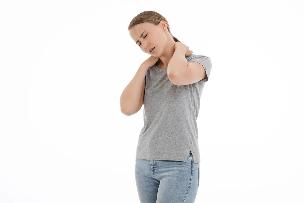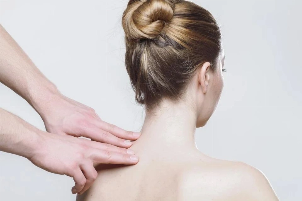
The main causes, symptoms and prevention of cervical osteochondrosis. Bonus: preventive gymnastics.
Osteochondrosis of the cervical spine is a degenerative-dystrophic lesion of the intervertebral discs in the cervical spine. The disease tends to progress with age and in the absence of treatment and prevention. Osteochondrosis is one of the most common diseases of the spine.
If you see pain in this area, you should see a doctor as soon as possible, because progressive osteochondrosis can lead to vision problems, up to persistent migraines, and even death.
Osteochondrosis is not necessarily an age-related change, but most often affects people at a young age.Eight main causes of osteochondrosis
- heredity,
- injuries,
- excessive physical activity,
- age-related changes,
- metabolic diseases,
- sedentary work (hypodynamics),
- Wrong body position during sleep,
- stress (psychosomatic).
If one or more symptoms occur, you should consult your doctor for treatment or prevention.
Causes of cervical osteochondrosis
The causes of cervical lumbar osteochondrosis can be different. Age-related changes alone cannot cause disease. The disease also affects young people who prefer sedentary work.
Inactivity is the most common cause of osteochondrosis. Moderate lack of exercise leads to muscle weakness and poor blood circulation. Further compression of the nerves and the appearance of an intervertebral hernia are possible.
Factors contributing to the development of cervical osteochondrosis
- Disruption of the structure and location of the brainstem relative to the spine and deformation of the first cervical vertebra.
- Acquired forms of deformation - kyphosis, lordosis, scoliosis and their combinations.
- Over 60 years old. At this age, age-related natural changes occur in the vertebral discs. Excessive growth of bone growth.
- Poor posture due to bending or prolonged restless posture.
- Cervical spine injuries.
- Wrong muscle loading.
- Obesity.
If the load on the muscles is not symmetrical, it can cause deformation. These changes are due to the habit of lifting weights with one hand, carrying a bag on one shoulder and using a very soft pillow while lying down.
Osteochondrosis rates
Modern science knows three main stages of development of cervical osteochondrosis. They differ in the degree of damage to the spine and treatment methods.
First-degree osteochondrosis
It begins with the rupture of the intervertebral disc capsule and the formation of micro-cracks in the ring fibrosis. This type is characterized by degenerative transformations in the cervical joints and changes in tissue structures.
First-degree symptoms of osteochondrosis:
joint and neck pain, vasoconstriction and impaired blood circulation in the neck and shoulder girdle;
- Appearance of pain in the neck with a sharp turn of the head, which indicates compression of the nerve endings;
- discomfort in the cervical region, temples, heart and constant headaches;
- blurred vision, the appearance of flies and curtains in the eyes.
Secondary osteochondrosis
It is characterized by a decrease in the distance between the vertebral discs. Any load causes a point pain, making it difficult to turn or bend the head.
Tertiary osteochondrosis
It is noted as a chronic disorder of spinal-muscular function. Significant changes in the structure of the spine are noticeable.
Lack of treatment at this stage can lead to stroke. Death is possible.
Signs of tertiary osteochondrosis:
- partial or complete paralysis of the neck and shoulder joints;
- Decreased sensitivity in the upper extremities;
- herniated disc becomes visible;
- Death of certain parts of the cerebral cortex due to circulatory disorders and insufficient oxygen supply.
In the third stage of osteochondrosis, surgery is required.
Signs of osteochondrosis in different parts of the spine
Symptoms of cervical osteochondrosis:

- Acute pain in the neck, upper extremities
- headaches,
- fingers can fit,
- high blood pressure,
- violation of coordination of movements,
- feel hard,
- nausea is not excluded,
- pain when swallowing,
- Painful sensations in the teeth are possible.
Symptoms of thoracic osteochondrosis:
- Chest pain that can spread to the heart and lungs, passes to the shoulder blades,
- painful sensations along the spine,
- rib pain,
- shoulder pain,
- spots in front of the eyes,
- tinnitus.
Lumbosacral osteochondrosis:
- menstrual disorders
- Lower back pain syndromes
- lumbago
- hernia between vertebrae
- increasing fatigue.
X-rays, CT and MRI, ultrasound and neuromyography are prescribed to women with suspected osteochondrosis. They may recommend consulting a mammologist and gynecologist to rule out osteochondrosis-like diseases with symptoms.
Osteochondrosis in women
As with men, there are three main types of osteochondrosis in women:
- cervical,
- waist,
- chest.
Women are more likely than men to develop osteochondrosis of the cervical and thoracic regions. This phenomenon is due to the strong development of the neck and chest muscles in men by nature. Thus, these departments have the best support. Therefore, it is necessary to strengthen the back and neck muscles as much as possible with appropriate movements.
Cervical osteochondrosis is most common in women who lead a sedentary lifestyle or are sedentary (office workers, salespeople, drivers) and thoracic osteochondrosis is most common in women with scoliosis since childhood.
Treatment of cervical osteochondrosis

You need to see a doctor to make a correct diagnosis. Other diseases can be hidden under the symptoms of cervical osteochondrosis.
Cervical osteochondrosis is not self-limiting and progressing to the final, third stage can be fatal.
Timely treatment will help prevent serious, irreversible consequences.
Diagnosis of osteochondrosis
An example list of specialist doctors to help you understand the problem.
- General practitioner (general practitioner). Therapists perform general diagnostics without treatment, prescribe general tests (urine, blood biochemistry). They take into account your individual complaints and refer you to the right specialist.
- Neurologist. A neurologist treats the early and middle stages of cervical osteochondrosis. At the stage of a neurological visit, as a rule, spinal radiography is performed. Appropriate treatment is selected for confirmed osteochondrosis.
- Trauma surgeon. The consultation of this specialist is determined if there are changes in the tissues. Maybe MRI, spondylography, CT appointment. Additional treatment is also selected.
- Neurosurgeon. Based on the results of CT and MRI, a consultation with a neurosurgeon is scheduled if an intervertebral hernia is suspected.
- Physiotherapist. Deals with the elimination of clinical manifestations of osteochondrosis.
- Rehabilitologist. Treatment by a rehabilitation therapist involves a recovery period after surgery. During this period, special therapeutic exercises (exercise therapy) are selected.
- Chiropractor. It is prescribed to relieve pain.
- Rheumatologist. Advises and diagnoses people with various forms of arthritis.
- Oncologist. Visits to the oncologist were indicated for suspected CT and MRI scans. Consultation with a specialist helps to confirm or rule out the presence of tumors of the bone tissue. A biopsy may be scheduled.
Modern methods of treatment of osteochondrosis:
- surgery (in case of irreversible changes,
- osteopathy,
- manual treatment,
- physiotherapy,
- massage,
- work with psychosomatics,
- reflexology,
- drug treatment.
Drug treatment
The goal of drug therapy is to relieve inflammation and pain. Properly selected drugs restore blood circulation and healthy tissue nutrition.
In the acute phase, drug treatment stabilizes the patient's condition and prepares him for the next stage of treatment. Ointments, muscle relaxants, corticosteroids and vitamin complexes are used.
Physiotherapy
Physiotherapy involves a combination of natural and hardware effects on the body. Effectively relieves pain & restores physical activity
Manual therapy
Manual therapy is effective when supervised by a good specialist.
Massage stimulates blood circulation and improves tissue nutrition. Manual therapy is suitable for home use (massage devices and various applicators).
You should consult a specialist before using hand-treated products at home.
Reflexology
Reflexology affects the body's biologically active points. Acupuncture, acupressure, can sometimes be performed in the form of moxibustion. If you choose this particular treatment method, make sure you have a qualified professional in front of you, as exposure to inappropriate biological points can have negative consequences.
exercise therapy
Physiotherapy exercises (OT) for osteochondrosis are definitely prescribed in the recovery phase. The goal of exercise therapy is to strengthen ligaments and muscles, and exercise helps restore blood flow.
Properly selected exercises can help prevent recurrence and deepening of the injury.
Exercises for cervical osteochondrosis
As a result, we bring to your attention a few exercises from the complex of physiotherapy exercises.
Consult a doctor before exercising.
Exercises in an exercise therapy complex can be uncomfortable, so try to relax as much as possible before doing it and make sure your breathing is calm and measured.
It is not recommended to overload your muscles during exercise. Do as much as you can, then relax and return to training.
To achieve the final recovery effect, the patient needs up to 300 movements in the spine and 100 repetitions for adjacent parts.
With cervical osteochondrosis, it is recommended to avoid sudden head movements. Exercises are performed on the legs, back straight, legs shoulder-width apart (repeat 15 times):
- Turn your head to the left, hold for 10 seconds. Put pressure on the shoulders, tighten the neck muscles and resist the pressure. Repeat the same actions to the right. Repeat the first work, bend back and forth.
- Turn your head to the right, try to reach your shoulders with your chin, hold the movement for a few seconds. Repeat the exercise by turning left.
- Use your chin to draw numbers from 0 to 9 in the air.
Back Exercises:
- Lift your head up and hold for 10 seconds. Keep your head down and take a five-second break.
- Pull your chin to the ceiling and hold for 10 seconds, then slowly lower your head.
Side Lying Exercises:
- Lift your head and hold it parallel to the floor for 10 seconds. Then slowly lower your head, pause for a few seconds.
- Repeat this process, lying on the other side.





































